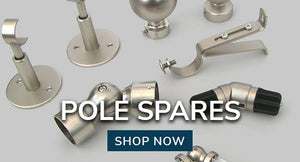How to use a cassette header rail system for a roman blind
Tools Required
To cut the headrail to size (where necessary) and to install it, you will need a few basic tools as follows: Drill and 6mm/8mm Drill Bit (for fixings supplied – see Screws & Plugs), Screw Driver, Hack Saw, Pencil, Tape Measure & Ruler.
What The Kit Includes
Your Cassette Roman Blind Kit will include everything that you need to make a Roman Blind except for your choice of fabric and lining if you are using it.
The Kits are available in 6 pre-manufactured sizes of 60cm, 90cm, 120cm, 150cm, 180cm and 210cm headrail lengths; but can be cut to size for a perfectly customized fit. This is particularly beneficial for blinds being fitted inside a window recess where an exact size is needed. If you are mounting a Roman Blind outside of a window recess, then in many cases you may be able to purchase the nearest pre-manufactured size to eliminate the need to do any cutting.
The table below details all the component parts included with your Kit and it is worth taking a few moments when you open it to familiarise yourself with all the parts and what they are called. Also check that you have everything you need before you start using or installing the Cassette Headrail.
- Headrail – this is a ‘U’ shaped track (either metal or PVC depending on which Kit you have purchased) containing several pre-corded bobbins called cassettes; and a central operating bar which runs the full length of the headrail. The front of the headrail is easily identifiable by the strip of hook tape. This is the (hard) hook side of the hook & loop tape which is used to attach the top edge of the blind to the headrail. The (soft) loop side of the tape, if not already pressed onto the hook tape is supplied in the Kit and needs to be stitched to the top edge of the blind during the making process.
- Cam Supports – These are the brackets which support the headrail. They can be top or faced fixed and use a pivoting cam mechanism to securely lock the header rail into them. This simple but effective locking mechanism means that once the brackets are installed, the headrail and blind can easily be installed and removed again in a few minutes.
N.B: We recommend that where possible, a professional or a person competent in DIY undertake the installation of the cam supports prior to installing the headrail and blind.
- Chain & Pulley Mechanism – The chain and pulley mechanism turn the central metal bar in the headrail, which in turn rotates the cord bobbins (cassettes) and winds the cords either up or down to raise or lower the blind. It is positioned as standard in the right-side end of the headrail in the Cassette Roman Blind Kits. This is referred to as a Right-Hand-Control but can be changed to the left-side end of the headrail if your blind needs to have a Left-Hand-Control.
- End Cap – This, as its name suggests, is a plastic cap covering the end of the U-shaped headrail which does not contain the Pulley Mechanism; and will be located on the left-side end of the headrail as standard when you open your Kit. It can be swapped from left to right depending on which side of the track you choose to have the Pulley Mechanism.
- Chain Safety Guide – This is a retainer which holds the continuous loop operating chain securely against the wall and under light tension, to comply with current Health & Safety regulations.
N.B: Children can be strangled if the chain safety guide is not installed correctly. Use of safety devices helps reduce the risk of strangulation but cannot be considered entirely fool proof.
- Roman Blind Rods (or Dowels) – These are the narrow rods which are inserted into the pocket tape. They are supplied in pre-cut lengths according to the Kit size you have purchased but can easily be trimmed to an exact size to fit the pocket tapes on the completed blind.
- Bottom Bar – This is a flat oval bar, made from weighty plastic which sits in a fabric pocket at the bottom of the blind. It keeps the bottom edge of the blind straight and adds weight to assist the blind in coming down effectively when it is lowered via the pulley mechanism. The bottom bar as with the rods/dowels can easily be cut to size.
- Hook On Cord Toggle – These are quick release safety toggles which are used to attach the cords to the bottom row of pocket tape. They have a spring-loaded toggle which releases the cord in the event of the blind being tugged on sharply. This helps to protect the blind from being damaged and provides an added safety measure.
N.B: Children can be strangled if the quick release cord toggles are not installed correctly. Use of safety devices helps reduce the risk of strangulation but cannot be considered entirely fool proof.
- Loop Tape – This is the soft side of the hook & loop tape which is used to attach the top edge of the blind to the headrail. The (hard) hook side of the tape is already attached to the headrail in a Cassette Roman Blind Kit and the length of (soft) loop tape provided needs to be stitched to the top edge of the blind during the making process.
- Pocket Roman Blind Tape – This is the tape which holds the rods/dowels in position across the back of the blind. It is also sometimes referred to as Rod-Pocket Tape. The tape is stitched into position, at regular horizontal intervals down the full length of the blind, to create channels into which to insert the rods/dowels; and has small pockets along its length through which cords are threaded at regular vertical intervals across the blind.
- Headrail Cutting Aid – This is a plastic support which is shaped to fit inside the headrail profile. Its purpose is two-fold. Once inserted into the headrail at the cutting point, it helps to keep the hollow profile of the headrail shape and prevent it from being crushed or distorted whilst cutting. It also provides a guide against which to cut with a hacksaw. Keeping the hacksaw blade close to or touching the guide, helps to keep the cut straight and neat, which is vital to ensuring that the end-cap or pulley mechanism can be refitted squarely again afterwards. The guide is removed and discarded after cutting.
- Screws & Plugs – In your kit you will find wall plugs and screws provided, to aid you in installing the Cam Support Brackets and the Chain Safety Guide. The shorter screws are for the Chain Safety Mechanism and the longer ones for the Cam Support Brackets.
N.B: Additional fixings other than those supplied with your Kit may be required depending on the mounting surface. Wallboard and plaster require the use of anchors such as expansion or toggle bolts. Brick, tile or stone need special plugs and drill bits. Always pre-drill holes in wood to avoid splitting.
What Else Will You Need?
The only thing not included in your Cassette Roman Blind Kit will be your fabric and lining (if you are using any). These will need to be purchased separately. To help you work out exactly how much fabric you will need try using our on-line fabric calculator. This calculator is present on all of our fabrics.
How to Change the Controls from right to left
Your cassette header rail will have been supplied with the chain and pulley mechanism already installed on the right-side end of the track. This means that when your blind is installed it will have a Right-Hand-Control.
Pro-Tip - for a more Professional finish: If you wish to change the controls from Right to Left and your headrail needs to be cut to size, then this step needs to be completed before cutting the headrail.
To change the headrail to a Left-Hand Control, place the track on a firm flat surface with the bottom edge facing upwards. Unscrew and remove the end-cap cover from the left-side end of the track.
Unscrew and remove the chain pulley mechanism from the right-side end of the track by carefully sliding it out of the end of the headrail.

Slide the pulley mechanism into the left-side end of the headrail, ensuring that the central steel bar of the headrail locates correctly into the square profile inside the pulley mechanism housing. Tighten the retaining screw again to secure the mechanism in place.
If your headrail does not need cutting to size you can now replace the end-cap cover on the ride-side end of the headrail and tighten the screw to secure it in place. If you need to cut your headrail to size then leave the end-cap off and keep reading the next section.
How to Correctly Cut the Track to Size
For this you will need a hacksaw, tape measure, pencil, a cross-head screwdriver and the Headrail Cutting Aid provided with the Cassette Roman Blind Kit.
Pro-Tip - for a more professional finish we recommend that you cut any excess off your headrail from the end which is NOT going to house the pulley mechanism, just in case the cut you make isn’t quite square or true. If the pulley mechanism is always fitted on the un-cut end of the headrail then it is guaranteed that it will fit securely and squarely; and therefore, operate more efficiently. For this reason, if you need to change the controls from Right to Left and your headrail needs to be cut to size, then change the control over before cutting the headrail.
Place the track on a firm flat surface with the bottom edge facing upwards. Unscrew and remove the end-cap cover from the left-side end of the track.

Loosen the screw on the first and second cassettes (cord bobbins) and slide them further along the headrail so that they are well clear of the cutting point. Loosen the small screw on the small white washer at the very end of the central steel bar (where appropriate - this may vary depending on kit type) and slide that along out of the way too.
Using a pencil and a tape measure, measure and mark the required cutting size on the headrail. With the end-cap cover removed and the cord guides moved out of the way, insert the cutting guide, with the tab upwards, into the end of the headrail; ensuring that the hole in the centre of the insert locates over the central steel bar of the headrail.
Slide the insert along to the marked cutting point, ensuring that the guide sits on the side of the headrail that you are keeping, not the side that you are cutting off. Using the edge of the insert and its tab as a guide, carefully trim the headrail using a fine-toothed hack saw; cutting through the header rail and the inner bar as you do so.
Remove the insert by sliding it out of the headrail again and reassemble the headrail by moving the small white washer back to the end of the central steel bar and tightening the screw; then replace the end-cap cover and tighten the screw.
Your headrail is now ready for you to attach and cord your blind.
How to Attach the Roman Blind to the Headrail
Before attaching your finished blind to the headrail, first turn your attention to adjusting the spacing between the cassette bobbins (or cord guides).
- Spacing the Cords – Turn the headrail upside down on a flat surface so that the bottom of the track is facing upwards. Loosen the screws on the cassette cord guides so that they can all slide freely along the central bar. Push the outer cord guide closest to the end of the blind which houses the pulley mechanism, as close to the pulley mechanism as it will go. This should put the cord approximately 8cm (3”) from the edge of the headrail. Move the outer cord guide at the opposite end of the headrail so that its cord is the same distance in from the end of the headrail too. Measure the distance between these two cords and space the remaining cord guides evenly so that the cords are equally spaced across the main body of the blind. Tighten the screws to secure the guides in place. Your cassette headrail should have been pre-assembled with the cassette bobbins (or cord guides) in the fully lowered position and should have no cord wrapped around them at this point. Check that this is the case before you proceed and adjust if necessary.
- Checking the Cassette Bobbins are Empty – With the bottom of the track still facing upwards as in the previous step, look at each cassette individually. If the cassettes are fully unwound and empty, you will see a short amount of cord sitting in a straight line across the cassette bobbin from the exit hole to the opposite side of each cassette.
If you can’t see this straight piece of cord and can instead see an amount of cord spiralled around the white plastic bobbin inside the clear plastic cassette, then the cassette is not fully unwound and will need adjusting. If you do not empty the cassettes by fully unwinding the bobbins, the cords will pull up at different lengths and may cause issues with the blind pulling up level.
To do this, undo all the cords from their coiled bundles and unravel them to their full lengths. With the headrail lying on its back and with the hook tape side facing upwards, gently turn the chain pulley a few notches until you can see the bobbins start to turn. Ensure you are turning in the correct direction for the bobbins to unwind and empty. If the bobbins are winding up more cord, then reverse the direction until the cassettes are empty. You may need to tug each cord gently and apply some tension to assist them in doing this.
Once you are happy that the cassette bobbins are all empty and the cords are fully unwound then your headrail is now ready for you to attach your blind to.
- Attaching the Blind – With the headrail lying on its back again and with the hook tape facing upwards, attach the blind by pressing the soft loop tape at the top of the blind firmly against the rough hook tape on the face of the headrail; ensuring that the blind is centralised and that the top of the headrail is covered by the top edge of the blind. If you’re not happy with the positioning, then simply peel the blind away again with care and reposition. When you are happy that your blind is positioned correctly press the top edge firmly to achieve good adhesion between the two loop tapes.
How to Cord the Blind
Turn the headrail (with the blind now attached to it) over, so that you are working from the back of the blind and the rod-pocket tapes are clearly visible. Working from one cassette at a time, the cords now need to be threaded vertically down the back of the blind, passing through one of the small guide pockets on each horizontal row of tape. Using a large sewing bodkin, small safety pin or a paperclip, thread the cords through the pocket guides as vertically in-line with the point where the cord comes out of the exit hole in the cassette bobbin as possible. If the cords run in straight lines parallel with the side edges of the blind, then you have threaded them correctly. If the cord looks crooked or slanted then they will need to be realigned as straight as possible to avoid the blind folding incorrectly as this can cause twisting and distortion when the blind is pulled up.

When you thread the cord through the guide pocket on the bottom row of tape, ensure that you pull all the cord down through it, so that the excess is all below the bottom rod-pocket tape, but do not cut ay of the excess cord off just yet.
Repeat the process for all the other cords.
Securing the Cords
The cords need to be secured to the bottom rod-pocket tape before the blind will operate properly. Do not attempt to operate the pulley mechanism before the cords are properly secured, as this will only result in the cords winding round the cassette bobbins at differing lengths, whilst not under tension; and will cause issues with the blind pulling up. You need to be quite accurate about this because if the cords are not all in the fully unwound position when they are secured to the bottom tape, you may find that the blind does not look level. Differing lengths, however slight the difference may be, will cause an uneven look to the folds or make the bottom edge of the blind look lob-sided.
The hook-on cord toggles now need to be attached to the bottom rod-pocket tape. With the open end of the hook on the back of the toggle pointing upwards and towards the blind, use a firm upward motion (as shown in Fig ?) to push the hook into a pocket guide on the bottom row of pocket tape, ensuring it is vertically in line with where the cord comes out of the cassette. Repeat for each row of cord until you have the same number of cord toggles as you do cords.
Now secure the cords as follows:
Squeeze the spring-loaded button at the side of the toggle to open the hole in the centre., pass the cord down through the top of the toggle, through the hole and pull all the excess cord through until it is all below the toggle, then release the spring-loaded button again.
It is important that you do not allow the cords to become twisted.
With the blind held in a level, vertical, position as it would be when mounted at the window (you may need someone to help you with this?), adjust the hook-on cord toggles so that equal tension is held on each cord and the bottom of the blind is running straight and parallel with the top edge. Do this by releasing the spring-loaded button on the toggles and sliding the cord through to the required position – ether slackening or tightening the cords as required. Release the button again to lock the cord in place.
You can now test the blind to see if it pulls up level and correctly by carefully operating the pulley mechanism to draw up all the folds (again, you may need someone to help you with this by holding the headrail firmly?). Look at the blind in the drawn-up position to see if all the folds and the bottom edge are level, then release the blind down to its fully closed position and check that it drops down just as evenly and that none of the cords are pulling any tighter than any of the others or any slacker. Adjust accordingly if they are, repeating the steps above. It is much easier to make any necessary adjustments at this point than when the blind is installed, as you may struggle to get behind the blind to make any adjustments once it is in situ.
Once you are happy that the cords are all adjusted correctly and that the blind is level, trim off the excess cord to a minimum of 4cms from the hook-on cord toggles and discard the excess. Do NOT knot the ends of the cords.
Do I have to use the Hook on Cord Toggles?
The hook-on cord toggles are necessary to meet health & safety measures required with your Cassette Roman Blind Kit. They are designed to be quick-release in the event of an accident, such as a young child or a pet becoming entangled in them. They are designed in such a way that the cords will slide out of the spring-loaded toggles when sharp or heavy pressure is applied to them, thus avoiding any serious accidents or damage to the blind itself.
The cords can slip out of the toggles if the blind is operated heavy-handedly or the pulley mechanism is wound too quickly. To avoid this happening, always use the blind respectfully and apply only even, steady, pressure and speed to the pulley mechanism. This will ensure the smooth operation and longevity of your blind and cassette headrail.
How to Hang the Headrail
Your blind and its cassette headrail are now ready to be installed at your window. Your Cassette Roman Blind Kit comes with the correct number of brackets for the width and weight of your blind, so it is advisable to fit them all to ensure a secure fixing and the safe operation of your blind.

The brackets provided with your kit are cam support brackets and can be either top or face fixed for inside or outside recess mounting.
Pro-Tip – For inside recess mounting ensure that the front edge of the header rail is slightly forward of any window catches or handles, to ensure that the blind does not catch on any fixtures as it is lowered and raised.
For outside recess fixing it is worth considering how far the window sill protrudes from the wall. If you have measured for your blind to come to sill height then this is not an issue, but if you have measured for your blind to come down beyond the sill level, then you will need to check if the depth of the sill protrusion is less than the depth of the header rail. If it is not, then you may have to mount a baton on the wall first, to bring the headrail forward enough for the blind to clear the sill; and then mount the brackets to the baton.
Fix the two outer brackets so that they will sit approximately 5-10cms (2-4”) from the outer ends of the headrail. Evenly space the remaining number of brackets between these two. Using appropriate fixings, drill and secure the cam support brackets into place, with the locking lever arm to the front.
To attach the headrail, firstly make sure that all the locking levers on the cam support brackets are in the fully open position (i.e. sticking out). Then, with the blind in the fully drawn up position, carefully peel the top edge of the blind away from the headrail and let it hang down onto the rest of the blind.
Now turn the pulley mechanism just enough to drop the blind down by about 2cm (1”) from the headrail. This gives easier access to the headrail, allows you to get your fingers under the headrail and helps you to see what you are doing more clearly. However, take care not to operate the pulley mechanism any further while the blind is like this.
Hold the header rail with both hands from underneath. With the back edge tilted down slightly, offer the lip inside the top front edge of the headrail onto the two flat tabs on the front edges of each the cam support brackets. With firm but careful pressure tilt the back edge of the headrail upwards until you feel it click into place and it fits flush underneath the cam support bracket; then close the locking levers until the front tab sits tight against the top edge of the headrail on each one, to lock the headrail into place.
Now reattach the blind. Replace the top fold by realigning the top edge of the blind with the top of the headrail and pressing the hook and loop tapes together again firmly, as you did when you first attached the blind to the headrail. Drop the blind fully to ensure it is fitted correctly then raise it again to the open position required.
Mounting the Chain Safety Guide
Please read the instructions carefully before installing and using the chain safety guide. Children can be strangled if the chain safety guide is not installed correctly. Use of safety devices helps to reduce the risk of strangulation but cannot be considered entirely fool proof.
With the chain safety guide on the chain, establish and mark a suitable mounting position for it at a point which keeps the chain taut. To do this, let the chain hang down with the safety guide acting as a light weight at the bottom of the continuous loop of chain, to help it to hang straight. Hold the safety guide firmly between finger and thumb and pull down on it gently to put the chain under light tension. Whilst holding it in this position press it to the wall and mark the position of the holes with a pencil. Use appropriate fixings (depending on the surface to which the device is being fitted) to mount the safety chain guide to the wall.

It is important that the chain is under the right amount of tension. If it is too slack the chain will be loose, creating a strangulation risk. If it is too taut, you will struggle to operate the blind smoothly and long term this could cause undue wear on the chain or damage to the pulley mechanism.
Current health & safety legislation guidelines require the safety guide to be installed not less than 1.5m from the floor. In addition, the chain drop cannot exceed 1m if the blind is less than 2.5m (99”) long.
The continuous loop of chain can be shortened where necessary, using the connector provided with the roman Blind Kit. The chain can be cut, shortened and reconnected using the small connector piece. If you have need to do this, however, you will need to consider that the connector cannot pass through the pulley mechanism.
How to Correctly shorten the Continuous Chain Loop on a Roman Blind
The headrails in Cassette Roman Blind kits are supplied with a continuous chain loop which has a standard drop of 1mtr. There is seldom a need to shorten the chain; particularly on outside recess mounted blinds. However, there may, on occasion, be the need to shorten the chain for inside recess blinds, if the recess height and therefore the blind length, are less than 1 metre.
If you do need to shorten the length of the continuous chain loop on your Roman blind, it is always better, where possible, to do this with the blind in situ as you will need to check that the amount you wish to shorten the chain by does not reduce the loop to such an extent that you cannot achieve a full rotation of the chain through the pulley mechanism; as this would prevent the blind from operating properly. If the loop cannot do a full rotation through the pulley mechanism then it may not be able to activate enough rotations of the cassettes to fully open or close the blind.
There is a simple way to check this before you cut the chain. With the blind in either the fully raised or fully lowered position, but not at a point in between; put a marker such as a piece of tape, thread or an elastic band round the front chain directly underneath the pully mechanism. Now operate the blind until it is in the fully lowered position. The distance between the marker and where the back chain goes into the pulley mechanism is the maximum amount of chain that can be removed. Cut the chain cord with scissors between two of the little chain balls to break the continuous loop, then take out the length of chain require to shorten it within the maximum amount available.
Your cassette Roman Blind Kit will have come with a chain connector (also sometimes know as an Ant’s Coffin). Insert the ball on one end of the chain into the centre slot of the connector and pull it towards the end to secure it. Repeat for the other end of the chain in the other end of the connector, then pinch the connector together gently with some pliers to ensure that the chain is secure. However, be aware that depending on where this attached that this connector may restrict the chain mechanism; meaning that the blind might not be able to be fully opened/closed.
How to Correctly Remove a Roman Blind Cassette Headrail
Removing a cassette headrail from the cam support brackets is quite a simple operation, but before you begin to do so, you must first remove the chain safety guide by unscrewing it from the wall and removing it from the continuous chain.
With the blind almost it its fully raised position, but not quite all the way up, peel the top of the blind away from the headrail and let it hang forward onto the rest of the blind so that you can access the headrail and see the tabs on the locking levers of the cam support brackets.
Using a flat head screwdriver, ease the locking levers open to unlock the headrail by inserting the screwdriver behind the tabs and gently prizing them forwards and to the left.
To remove the headrail grasp it firmly from underneath with both hands and gently tilt the back edge of the headrail down a little. Ease the front edge towards you and away from the brackets until it disengages from the two prongs on the front edge of the cam support brackets.
What do I do if a cord comes out of one of the Hook-On Cord Toggles?
If a cord, or more than one maybe, becomes detached from the hook-on cord toggle(s), it’s relevant cassette will still operate and wind the cord around its bobbin as the pulley mechanism is turned; but with no anchor at the bottom to secure it, the end of the cord is very likely to disappear inside the headrail and cassette mechanism, where it is not visible or easily retrievable.
If this happens you will need to take the blind and headrail down to retrieve and rethread the cord(s). There is no need to detach the blind from the headrail, take them down together as a complete unit.
With the blind in its fully lowered position and working from the back of the blind, lay it on a flat surface with the underneath of the headrail facing upwards and identify which cassette(s) need to have their cords retrieved. The cassettes which no longer have their cords visibly threaded down the back of the blind will need to be removed from the headrail before you can retrieve the lost end of the cord.
The cassettes can only be removed from the headrail by being moved along the central bar inside it and out at one end. If the cassette(s) that you need to remove have other cassettes to either side of them which are still corded, then those cassettes will need to be removed too.
Where possible leave the pulley mechanism in place and remove the cassettes from the opposite end of the headrail which houses the simple end cap.
Before you move any of the cassettes whose cords are still attached to the blind, you will need to release their cords from the safety toggles on the bottom row of rod pocket tape, as they will not slide out of the headrail whilst their cords are still threaded down through the rod pocket tapes. You do not need to unthread any cassettes or rows of cord that do not need to be moved.
Unscrew and remove the end cap and undo the tightening screws on the cassettes that need to be moved. One at a time, carefully slide the cassettes along the central bar in the headrail and out at the end.
Once you have removed all the necessary cassettes, put the ones that are still threaded correctly to one side whilst you retrieve the cords on the ones that have come unthreaded.
The cassettes have two parts. A clear plastic outer section which is the cassette casing and a white plastic inner tube which sits inside it which is the bobbin. Remove the inner bobbin from the outer casing by lifting it up and out of the end of the cassette casing which has the open ‘v’ shaped section. Then, slide it out of the enclosed circular section at the other end.
One end of the bobbin spool is removable, as it houses the knotted end of the cord which stays attached to the bobbin. Don’t worry if this end of the bobbin spool pops out as you remove the bobbin from the cassette but ensure that the knotted end of the cord is still securely fastened in its retaining slot and replace the end piece.
Find the end of the cord which has come undone from the safety toggle and thread it down through the small circular hole in the clear cassette casing, which is located nearest to the enclosed circular end. Pull all the cord through the hole until the cassette is empty then reassemble the bobbin and cassette by inserting the bobbin back into the clear cassette casing, reversing the removal process and ensuring that the bobbin end stop is still in place and that this end of the bobbin clicks firmly back into the end of the cassette casing with the open ‘v’ section as before.
Repeat for all the bobbins that need to be rethreaded. Once all the necessary cassettes have been reloaded you can reassemble all the cassettes into the headrail. As you re-insert each cassette into the headrail, check first that the cord is fully unwound and there is none left coiled around the bobbin. If you look at the cassette from underneath, you should be able to see a straight piece of cord going from the knotted fixed side of the bobbin across to the exit hole on the opposite side of the cassette.
Slide the cassettes back into the headrail one by one and after replacing the end cap securely, reposition them with the correct spacing between, as you did when the blind was assembled. i.e. - Push the cord guide nearest to the end of the headrail which houses the pulley mechanism, as far up against the pulley mechanism as it will go. This should place the cord approximately 8cm (3”) from the edge of the blind. Move the cassette at the opposite end of the blind so that its cord is the same distance from the edge of the blind. Measure the distance between these two cords and space the remaining cord guides evenly so that the cords are equally spaced across the main body of the blind. Tighten the screws to secure the guides in place.
Check once more that all the cassette bobbins are fully unwound and empty and if so, restring the blind by threading the cords down through the horizontal rows of rod pocket tape and reattaching the safety toggles. Then just re-attach the headrail and blind to the cam support brackets, and you're all done.

Young children can be strangled by loops in pull cords, chains, tapes and cords that operate the product. To avoid strangulation and entanglement, keep cords out of the reach of young children. Cords may become wrapped around a child’s neck. Move beds, cots and furniture away from window covering cords. Make sure cords do not twist and create a loop. Children can strangle if the chain safety guide device is not installed. Always use this device to keep chain out of read of children.


























































